6.2 Basic Ethical Concepts
The American Nurses Association (ANA) defines morality as “personal values, character, or conduct of individuals or groups within communities and societies,” whereas ethics is the formal study of morality from a wide range of perspectives.[1] Ethics is considered so important in the role of a nurse that it is ANA’s first Standard of Professional Performance. The ANA Standards of Professional Nursing Practice are “authoritative statements of the actions and behaviors that all registered nurses, regardless of role, population, specialty, and setting, are expected to perform competently.” See the following box for the competencies associated with the ANA Ethics Standard of Professional Performance.[2]
Ethics Competencies in ANA’s Standard of Professional Performance[3]
- Uses the Code of Ethics for Nurses with Interpretive Statements as a moral foundation to guide nursing practice and decision-making.
- Demonstrates that every person is worthy of nursing care through the provision of respectful, person-centered, compassionate care, regardless of personal history or characteristics (Beneficence).
- Advocates for health care consumer perspectives, preferences, and rights to informed decision-making and self-determination (Respect for autonomy).
- Demonstrates a primary commitment to the recipients of nursing and health care services in all settings and situations (Fidelity).
- Maintains therapeutic relationships and professional boundaries.
- Safeguards sensitive information within ethical, legal, and regulatory parameters (Non-maleficence).
- Identifies ethics resources within the practice setting to assist and collaborate in addressing ethical issues.
- Integrates principles of social justice in all aspects of nursing practice (Justice).
- Refines ethical competence through continued professional education and personal self-development activities.
- Depicts one’s professional nursing identity through demonstrated values and ethics, knowledge, leadership, and professional comportment.
- Engages in self-care and self-reflection practices to support and preserve personal health, well-being, and integrity.
- Contributes to the establishment and maintenance of an ethical environment that is conducive to safe, quality health care.
- Collaborates with other health professionals and the public to protect human rights, promote health diplomacy, enhance cultural sensitivity and congruence, and reduce health disparities.
- Represents the nursing perspective in clinic, institutional, community, or professional association ethics discussions.
Reflective Questions
- What Ethics competencies have you already demonstrated during your nursing education?
- What Ethics competencies are you most interested in performing next?
- What questions do you have about the ANA’s Ethics competencies?
ANA’s Code of Ethics for Nurses with Interpretive Statements is a moral foundation that guides nursing practice and ethical decision-making.[4] This section will review several basic ethical concepts related to the ANA’s Ethics Standard of Professional Performance, such as values, morals, ethical theories, ethical principles, and the ANA Code of Ethics for Nurses.
Values
Values are individual beliefs that motivate people to act one way or another and serve as a guide for behavior considered “right” and “wrong.” People tend to adopt the values that they are raised with and believe those values are “right” because they are the values of their culture. Some personal values are considered sacred and moral imperatives based on an individual’s religious beliefs.[5] See Figure 6.1[6] for an image depicting values.

In addition to personal values, organizations also establish values. The American Nurses Association (ANA) Professional Nursing Model states that nursing is based on values such as caring, compassion, presence, trustworthiness, diversity, acceptance, and accountability. These values emerge from nursing practice beliefs, such as the importance of relationships, service, respect, willingness to bear witness, self-determination, and the pursuit of health.[7] As result of these traditional values and beliefs by nurses, Americans have ranked nursing as the most ethical and honest profession in Gallup polls since 1999, with the exception of 2001 when firefighters earned the honor after the attacks on September 11.[8]
The National League of Nursing (NLN) has also established four core values for nursing education: caring, integrity, diversity, and excellence:[9]
- Caring: Promoting health, healing, and hope in response to the human condition.
- Integrity: Respecting the dignity and moral wholeness of every person without conditions or limitations.
- Diversity: Affirming the uniqueness of and differences among persons, ideas, values, and ethnicities.
- Excellence: Cocreating and implementing transformative strategies with daring ingenuity.
Morals
Morals are the prevailing standards of behavior of a society that enable people to live cooperatively in groups. “Moral” refers to what societies sanction as right and acceptable. Most people tend to act morally and follow societal guidelines, and most laws are based on the morals of a society. Morality often requires that people sacrifice their own short-term interests for the benefit of society. People or entities that are indifferent to right and wrong are considered “amoral,” while those who do evil acts are considered “immoral.”[11]
Ethical Theories
There are two major types of ethical theories that guide values and moral behavior referred to as deontology and consequentialism.
Deontology is an ethical theory based on rules that distinguish right from wrong. See Figure 6.2[12] for a word cloud illustration of deontology. Deontology is based on the word Deon that refers to “duty.” It is associated with philosopher Immanuel Kant. Kant believed that ethical actions follow universal moral laws, such as, “Don’t lie. Don’t steal. Don’t cheat.”[13] Deontology is simple to apply because it just requires people to follow the rules and do their duty. It doesn’t require weighing the costs and benefits of a situation, thus avoiding subjectivity and uncertainty.[14],[15],[16]
The nurse-patient relationship is deontological in nature because it is based on the ethical principles called beneficence and maleficence that drive clinicians to “do good” and “avoid harm.”[17] Ethical principles will be discussed further in this chapter.
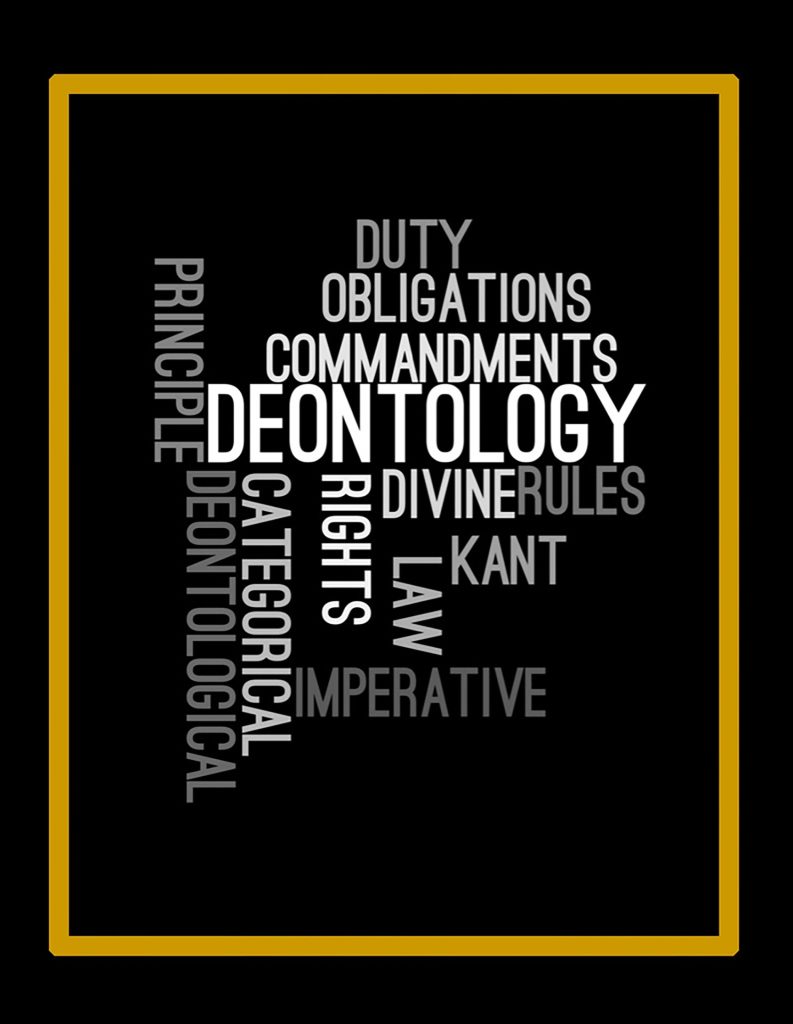
Consequentialism is an ethical theory that judges whether or not an action is right by the consequences of the action. See Figure 6.3[19] for an illustration of weighing the consequences of an action in consequentialism. For example, most people agree that lying is wrong. But if telling a lie would help save a person’s life, consequentialism says it’s the right thing to do. One type of consequentialism is utilitarianism. Utilitarianism judges actions by their consequences with the standard of achieving the greatest good for the greatest number of people.[20],[21],[22] For this reason, utilitarianism tends to be society-centered. When applying utilitarian ethics to health care resources, money, time, and clinician energy are considered finite resources that should be appropriately allocated to achieve the best health care for society.[23]
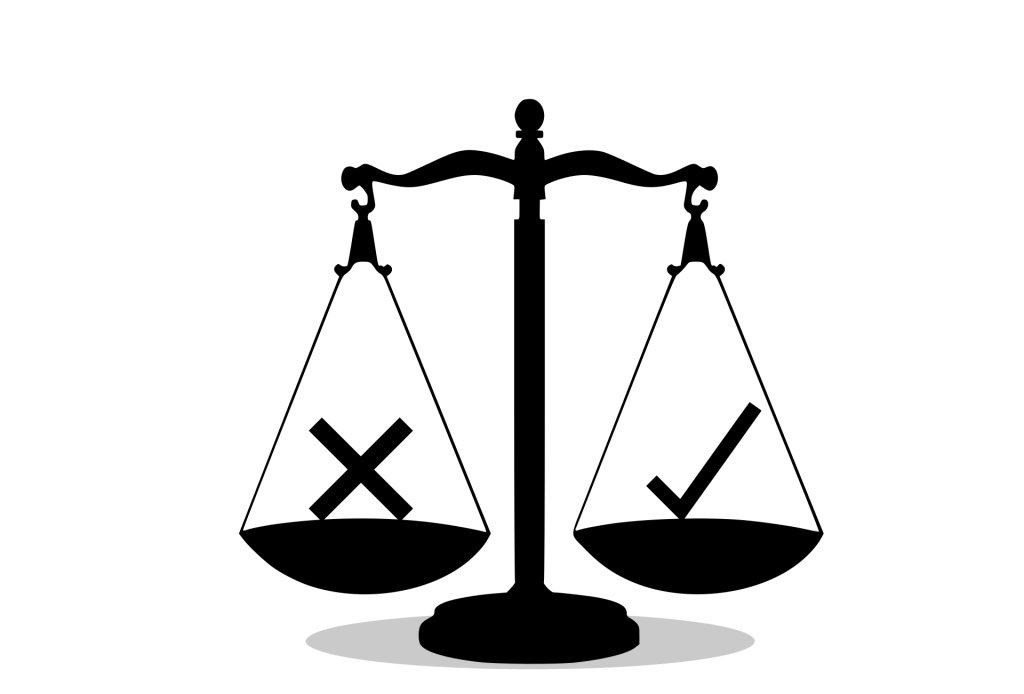
However, utilitarianism can be complicated when accounting for values such as justice and individual rights. For example, assume a hospital has four patients whose lives depend upon receiving four organ transplant surgeries for a heart, lung, kidney, and liver. If a healthy person without health insurance or family support experiences a life-threatening accident and is comatose but kept alive on life-sustaining equipment in the ICU, the utilitarian framework might suggest the organs be harvested to save four lives at the expense of one life.[24] This action could arguably produce the greatest good for the greatest number of people, but the deontological approach could argue this action would be unethical because it does not follow the rule of “do no harm.”
Read more about Decision making on organ donation: The dilemmas of relatives of potential brain dead donors.
Interestingly, deontological and utilitarian approaches to ethical issues may result in the same outcome, but the rationale for the outcome or decision is different because it is focused on duty (deontologic) versus consequences (utilitarian).
Societies and cultures have unique ethical frameworks and may include the application of either deontological or consequentialist ethical theory. Culturally-derived deontological rules may apply to ethical issues in health care. For example, a traditional Chinese philosophy based on Confucianism results in a culturally-acceptable practice of family members (rather than the client) receiving information from health care providers about life-threatening medical conditions and making treatment decisions. As a result, cancer diagnoses and end-of-life treatment options may not be disclosed to the client in an effort to alleviate the suffering that may arise from knowledge of their diagnosis. In this manner, a client’s family and the health care provider may ethically prioritize a client’s psychological well-being over their autonomy and self-determination.[26] However, in the United States, this ethical decision may conflict with HIPAA Privacy Rules and the ethical principle of patient autonomy. As a result, a nurse providing patient care in this type of situation may experience an ethical dilemma.
See Table 6.2 comparing common ethical issues in health care viewed through the lens of deontological and consequential ethical frameworks.
Table 6.2 Ethical Issues Through the Lens of Deontological or Consequential Ethical Frameworks
| Ethical Issue | Deontological View | Consequential View |
|---|---|---|
| Abortion | Abortion is unacceptable based on the rule of preserving life. | Abortion may be acceptable in cases of an unwanted pregnancy, rape, incest, or risk to the mother. |
| Bombing an area with known civilians | Killing civilians is not acceptable due to the loss of innocent lives. | The loss of innocent lives may be acceptable if the bombing stops a war that could result in significantly more deaths than the civilian casualties. |
| Stealing | Taking something that is not yours is wrong. | Taking something to redistribute resources to others in need may be acceptable. |
| Killing | It is never acceptable to take another human being’s life. | It may be acceptable to take another human life in self-defense or to prevent additional harm they could cause others. |
| Euthanasia/physician- assisted suicide | It is never acceptable to assist another human to end their life prematurely. | End-of-life care can be expensive and emotionally upsetting for family members. If a competent, capable adult wishes to end their life, medically supported options should be available. |
| Vaccines | COVID-19 vaccination is a personal choice based on religious practices or other beliefs. | COVID-19 vaccination should be mandatory for everyone (without a medical contraindication) because of its greater good for all of society. |
Ethical Principles and Obligations
Ethical principles are used to define nurses’ moral duties and aid in ethical analysis and decision-making.[27] Although there are many ethical principles that guide nursing practice, foundational ethical principles include autonomy (self-determination), beneficence (do good), nonmaleficence (do no harm), justice (fairness), and veracity (tell the truth).
Autonomy
The ethical principle of autonomy recognizes each individual’s right to self-determination and decision-making based on their unique values, beliefs, and preferences. See Figure 6.4[28] for an illustration of autonomy. The American Nurses Association (ANA) defines autonomy as the “capacity to determine one’s own actions through independent choice, including demonstration of competence.”[29] The nurse’s primary ethical obligation is client autonomy.[30] Based on autonomy, clients have the right to refuse nursing care and medical treatment. An example of autonomy in health care is advance directives. Advance directives allow clients to specify health care decisions if they become incapacitated and unable to do so.
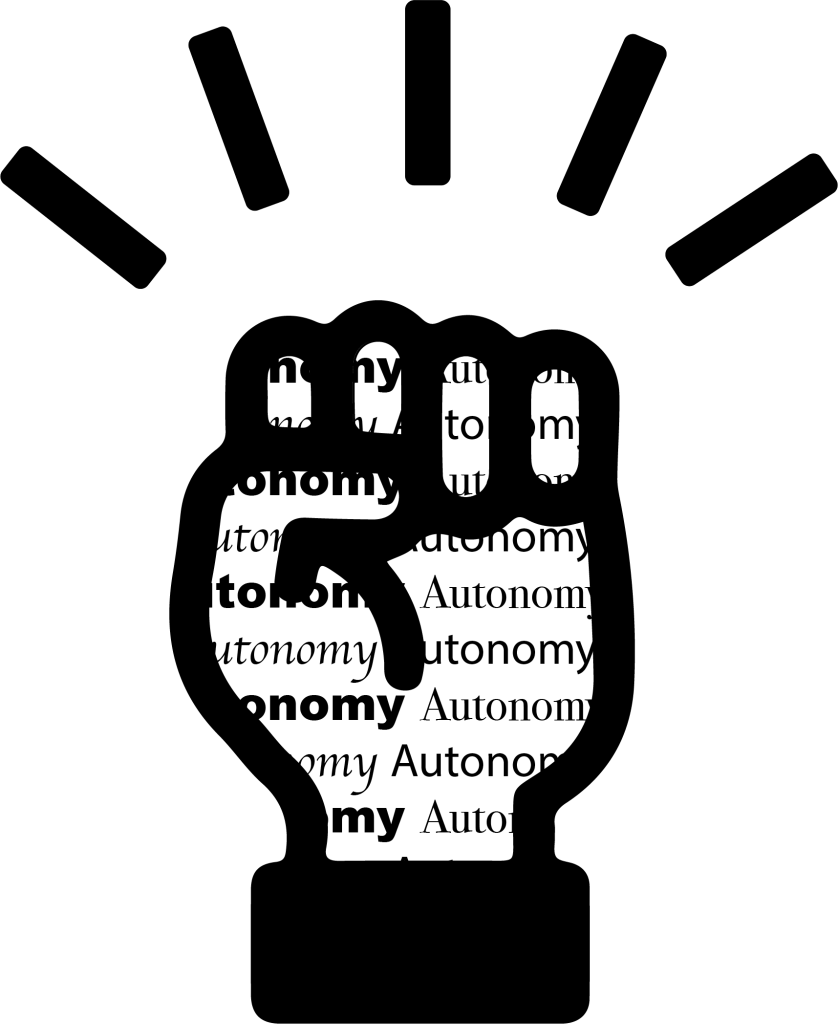
Read more about advance directives and determining capacity and competency in the “Legal Implications” chapter.
Nurses as Advocates: Supporting Autonomy
Nurses have a responsibility to act in the interest of those under their care, referred to as advocacy. The American Nurses Association (ANA) defines advocacy as “the act or process of pleading for, supporting, or recommending a cause or course of action. Advocacy may be for persons (whether an individual, group, population, or society) or for an issue, such as potable water or global health.”[31] See Figure 6.5[32] for an illustration of advocacy.

Advocacy includes providing education regarding client rights, supporting autonomy and self-determination, and advocating for client preferences to health care team members and family members. Nurses do not make decisions for clients, but instead support them in making their own informed choices. At the core of making informed decisions is knowledge. Nurses serve an integral role in patient education. Clarifying unclear information, translating medical terminology, and making referrals to other health care team members (within their scope of practice) ensures that clients have the information needed to make treatment decisions aligned with their personal values.
At times, nurses may find themselves in a position of supporting a client’s decision they do not agree with and would not make for themselves or for the people they love. However, self-determination is a human right that honors the dignity and well-being of individuals. The nursing profession, rooted in caring relationships, demands that nurses have nonjudgmental attitudes and reflect “unconditional positive regard” for every client. Nurses must suspend personal judgement and beliefs when advocating for their clients’ preferences and decision-making.[33]
Beneficence
Beneficence is defined by the ANA as “the bioethical principle of benefiting others by preventing harm, removing harmful conditions, or affirmatively acting to benefit another or others, often going beyond what is required by law.”[34] See Figure 6.6[35] for an illustration of beneficence. Put simply, beneficence is acting for the good and welfare of others, guided by compassion. An example of beneficence in daily nursing care is when a nurse sits with a dying patient and holds their hand to provide presence.
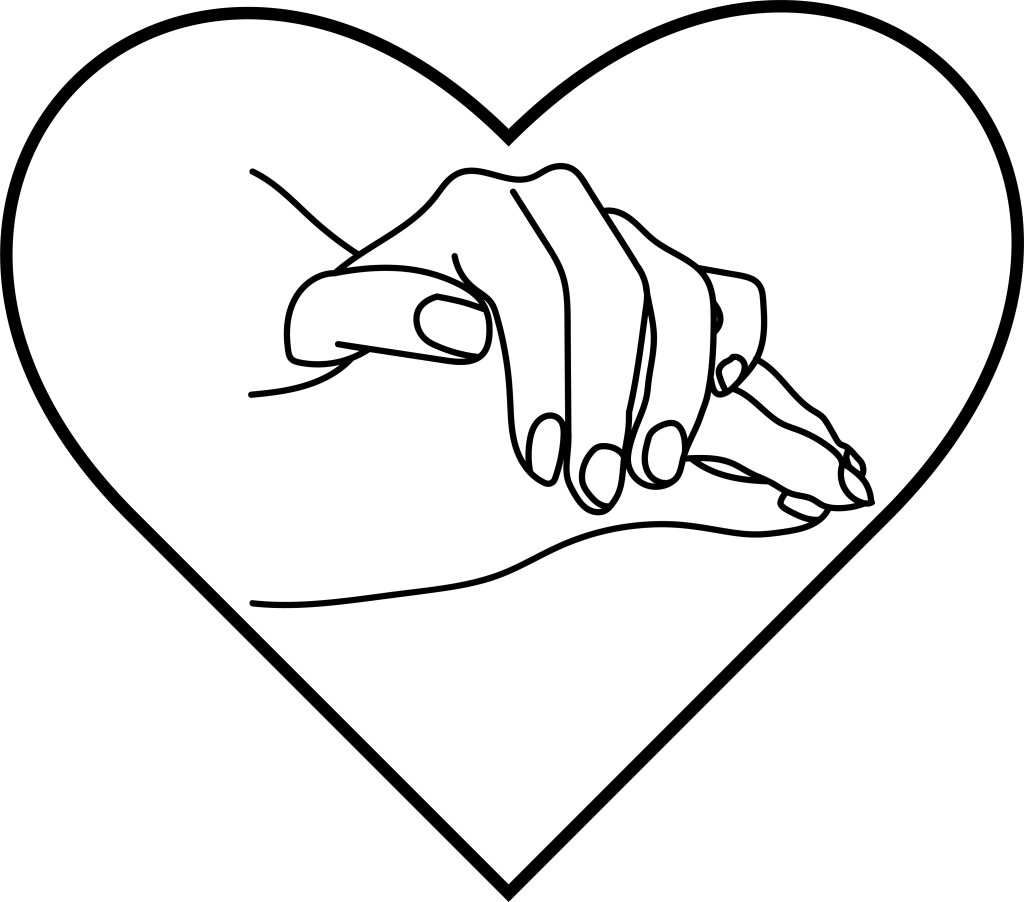
Nursing advocacy extends beyond direct patient care to advocating for beneficence in the communities we serve. Vulnerable populations such as children, older adults, cultural minorities, and the homeless often benefit from nurse advocacy in promoting health equity. Cultural humility is a humble and respectful attitude towards individuals of other cultures and an approach to learning about other cultures as a lifelong goal and process.[36] Nurses, the largest segment of the health care community, have a powerful voice when addressing community beneficence issues, such as health disparities and social determinants of health, and can serve as the conduit for advocating for change.
Nonmaleficence
Nonmaleficence is defined by the ANA as “the bioethical principle that specifies a duty to do no harm and balances avoidable harm with benefits of good achieved.”[37] See Figure 6.7[38] for an illustration of avoiding harm. An example of doing no harm in nursing practice is reflected by nurses checking medication rights three times before administering medications. In this manner, medication errors can be avoided and the duty to do no harm is met. Another example of nonmaleficence is when a nurse assists a client with a serious, life-threatening condition to participate in decision-making regarding their treatment plan. By balancing the potential harm with potential benefits of various treatment options, while also considering quality of life and comfort, the client can effectively make decisions based on their values and preferences.
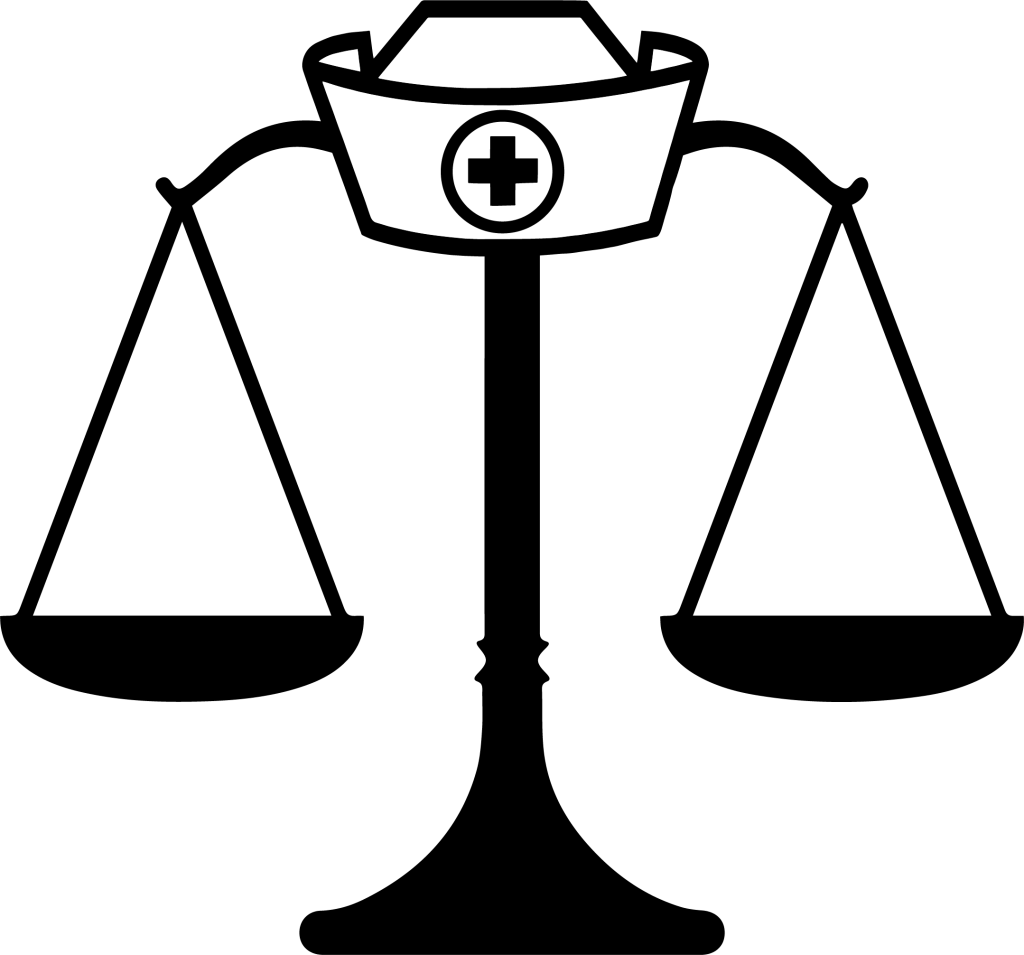
Justice
Justice is defined by the ANA as “a moral obligation to act on the basis of equality and equity and a standard linked to fairness for all in society.”[39] See Figure 6.8[40] for an illustration of promoting justice. The principle of justice requires health care to be provided in a fair and equitable way. Nurses provide quality care for all individuals with the same level of fairness despite the individual’s financial status, culture, religion, gender, or sexual orientation. Nurses have a social contract with society to “provide compassionate care that addresses the individual’s needs for protection, advocacy, empowerment, optimization of health, prevention of illness and injury, alleviation of suffering, comfort, and well-being.”[41] An example of a nurse using the principle of justice in daily nursing practice is effective prioritization based on client needs.
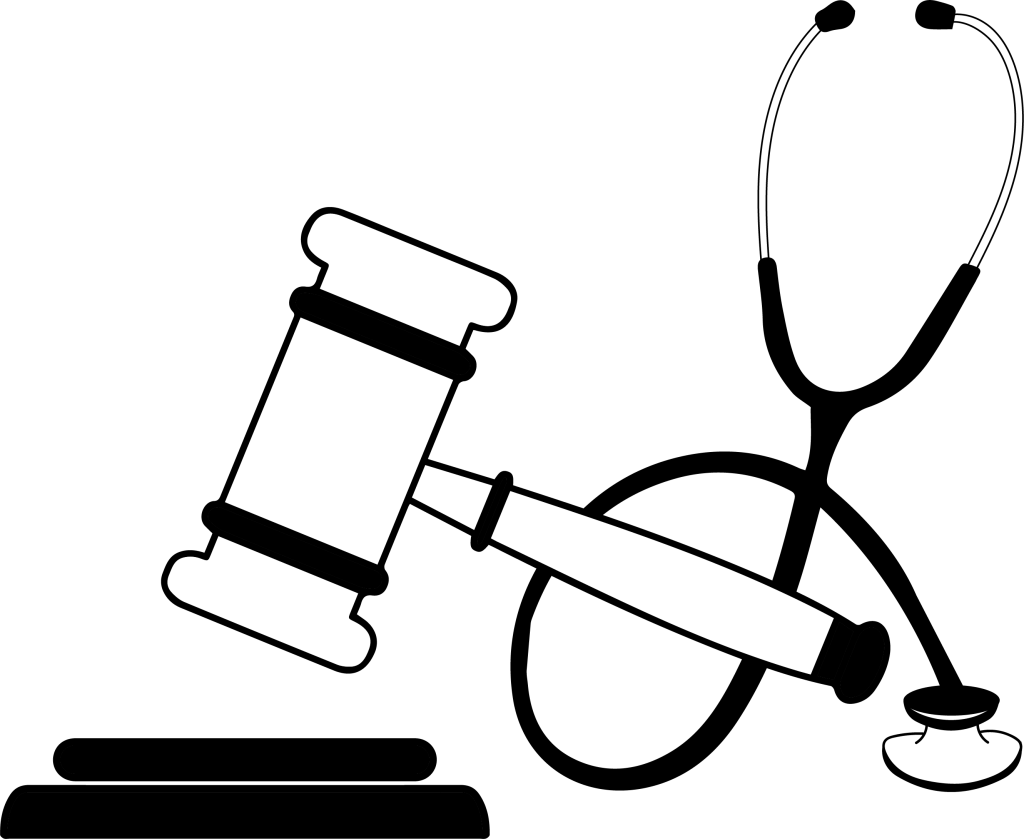
Read more about prioritization models in the “Prioritization” chapter.
Other Ethical Principles
Additional ethical principles commonly applied to health care include fidelity (keeping promises) and veracity (telling the truth). See Figure 6.9[42] for an illustration of honesty. An example of fidelity in daily nursing practice is when a nurse tells a client, “I will be back in an hour to check on your pain level.” This promise is kept. An example of veracity in nursing practice is when a nurse does not use false reassurance to comfort a patient but instead focuses on other therapeutic interventions to promote coping. Determining how truthfulness will benefit the client and support their autonomy is dependent on a nurse’s clinical judgment, self-reflection, knowledge of the patient and their cultural beliefs, and other factors.[43]

A principle historically associated with health care is paternalism. Paternalism is defined as the interference by the state or an individual with another person, defended by the claim that the person interfered with will be better off or protected from harm.[44] Paternalism is the basis for legislation related to drug enforcement and compulsory wearing of seatbelts. See Figure 6.10[45] for an illustration of paternalism.

In health care, paternalism has been used as rationale for performing treatment based on what the provider believes is in the client’s best interest. In some situations, paternalism may be appropriate for individuals who are unable to comprehend information in a way that supports their informed decision-making, but it must be used cautiously to ensure vulnerable individuals are not misused and their autonomy is not violated.
Nurses may find themselves acting paternalistically when performing nursing care to ensure client health and safety. For example, repositioning clients to prevent skin breakdown is a preventative intervention commonly declined by clients when they prefer a specific position for comfort. In this situation, the nurse should explain the benefits of the preventative intervention and the risks if the intervention is not completed. If the client continues to decline the intervention despite receiving this information, the nurse should document the education provided and the client’s decision to decline the intervention. The process of reeducating the client and reminding them of the importance of the preventative intervention should be continued at regular intervals and documented.
Care-Based Ethics
Nurses use a client-centered, care-based ethical approach to patient care that focuses on the specific circumstances of each situation. This approach aligns with nursing concepts such as caring, holism, and a nurse-client relationship rooted in dignity and respect through virtues such as kindness and compassion.[46],[47] This care-based approach to ethics uses a holistic, individualized analysis of situations rather than the prescriptive application of ethical principles to define ethical nursing practice. This care-based approach asserts that ethical issues cannot be handled deductively by applying concrete and prefabricated rules, but instead require social processes that respect the multidimensionality of problems.[48] Frameworks for resolving ethical situations are discussed in the “Ethical Dilemmas” subsection of this chapter.
Nursing Code of Ethics
Many professions and institutions have their own set of ethical principles, referred to as a code of ethics, designed to govern decision-making and assist individuals to distinguish right from wrong. The American Nurses Association (ANA) provides a framework for ethical nursing care and guides nurses during decision-making in its formal document titled Code of Ethics for Nurses With Interpretive Statements (Nursing Code of Ethics). The Nursing Code of Ethics serves the following purposes:[49]
- It is a succinct statement of the ethical values, obligations, duties, and professional ideals of nurses individually and collectively.
- It is the profession’s nonnegotiable ethical standard.
- It is an expression of nursing’s own understanding of its commitment to society.
The preface of ANA’s Nursing Code of Ethics states, “Individuals who become nurses are expected to adhere to the ideals and moral norms of the profession and also to embrace them as a part of what it means to be a nurse. The ethical tradition of nursing is self-reflective, enduring, and distinctive. A code of ethics makes explicit the primary goals, values, and obligations of the profession.”[50]
The Nursing Code of Ethics contains nine provisions. Each provision contains several clarifying or “interpretive” statements. Read a summary of the nine provisions in the following box.
Nine Provisions of the ANA Nursing Code of Ethics
- Provision 1: The nurse practices with compassion and respect for the inherent dignity, worth, and unique attributes of every person.
- Provision 2: The nurse’s primary commitment is to the patient, whether an individual, family, group, community, or population.
- Provision 3: The nurse promotes, advocates for, and protects the rights, health, and safety of the patient.
- Provision 4: The nurse has authority, accountability, and responsibility for nursing practice; makes decisions; and takes action consistent with the obligation to promote health and to provide optimal care.
- Provision 5: The nurse owes the same duties to self as to others, including the responsibility to promote health and safety, preserve wholeness of character and integrity, maintain competence, and continue personal and professional growth.
- Provision 6: The nurse, through individual and collective effort, establishes, maintains, and improves the ethical environment of the work setting and conditions of employment that are conducive to safe, quality health care.
- Provision 7: The nurse, in all roles and settings, advances the profession through research and scholarly inquiry, professional standards development, and the generation of both nursing and health policy.
- Provision 8: The nurse collaborates with other health professionals and the public to protect human rights, promote health diplomacy, and reduce health disparities.
- Provision 9: The profession of nursing, collectively through its professional organizations, must articulate nursing values, maintain the integrity of the profession, and integrate principles of social justice into nursing and health policy.
Read the free, online full version of the ANA’s Code of Ethics for Nurses With Interpretive Statements.
In addition to the Nursing Code of Ethics, the ANA established the Center for Ethics and Human Rights to help nurses navigate ethical conflicts and life-and-death decisions common to everyday nursing practice.
Read more about the ANA Center for Ethics and Human Rights.
Specialty Organization Code of Ethics
Many specialty nursing organizations have additional codes of ethics to guide nurses practicing in settings such as the emergency department, home care, or hospice care. These documents are unique to the specialty discipline but mirror the statements from ANA’s Nursing Code of Ethics. View ethical statements of various specialty nursing organizations using the information in the following box.
Ethical Statements of Selected Specialty Nursing Organizations
- American Nurses Association. (2015). Code of ethics for nurses with interpretive statements. American Nurses Association. https://www.nursingworld.org/practice-policy/nursing-excellence/ethics/code-of-ethics-for-nurses/coe-view-only/ ↵
- American Nurses Association. (2021). Nursing: Scope and standards of practice (4th ed.). American Nurses Association. ↵
- American Nurses Association. (2021). Nursing: Scope and standards of practice (4th ed.). American Nurses Association. ↵
- American Nurses Association. (2015). Code of ethics for nurses with interpretive statements. American Nurses Association. https://www.nursingworld.org/practice-policy/nursing-excellence/ethics/code-of-ethics-for-nurses/coe-view-only/ ↵
- Ethics Unwrapped - McCombs School of Business. (n.d.). Ethics defined (a glossary). University of Texas at Austin. https://ethicsunwrapped.utexas.edu/glossary ↵
- “ethics-2991600_1920” by Tumisu is licensed under CC0 1.0 ↵
- American Nurses Association. (2021). Nursing: Scope and standards of practice (4th ed.). American Nurses Association. ↵
- Gaines, K. (2021, January 19). Nurses ranked most trusted profession 19 years in a row. Nurse.org. https://nurse.org/articles/nursing-ranked-most-honest-profession/ ↵
- National League for Nursing. Core values. http://www.nln.org/about/core-values ↵
- McCombs School of Business. (2018, December 18). Values | Ethics defined. [Video]. YouTube. All rights reserved. https://youtu.be/SCjYaatMJuY ↵
- Ethics Unwrapped - McCombs School of Business. (n.d.). Ethics defined (a glossary). University of Texas at Austin. https://ethicsunwrapped.utexas.edu/glossary ↵
- “ethics-947572_1920” by rdaconnect at Pixabay.com is licensed under CC0 1.0 ↵
- Ethics Unwrapped - McCombs School of Business. (n.d.). Ethics defined (a glossary). University of Texas at Austin. https://ethicsunwrapped.utexas.edu/glossary ↵
- Alexander, L., & Moore, M. (2020, October 30). Deontological ethics. Stanford Encyclopedia of Psychology. https://plato.stanford.edu/entries/ethics-deontological/ ↵
- Ethics Unwrapped - McCombs School of Business. (n.d.). Ethics defined (a glossary). University of Texas at Austin. https://ethicsunwrapped.utexas.edu/glossary ↵
- American Nurses Association. (2021). Nursing: Scope and standards of practice (4th ed.). American Nurses Association. ↵
- Mandal, J., Ponnambath, D. K., & Parija, S. C. (2016). Utilitarian and deontological ethics in medicine. Tropical Parasitology, 6(1), 5–7. https://doi.org/10.4103/2229-5070.175024 ↵
- McCombs School of Business. (2018, December 18). Deontology | Ethics defined. [Video]. YouTube. All rights reserved. https://youtu.be/wWZi-8Wji7M ↵
- “balance-6097898_1280” by mohamed_hassan is licensed under CC0 1.0 ↵
- Alexander, L., & Moore, M. (2020, October 30). Deontological ethics. Stanford Encyclopedia of Psychology. https://plato.stanford.edu/entries/ethics-deontological/ ↵
- Ethics Unwrapped - McCombs School of Business. (n.d.). Ethics defined (a glossary). University of Texas at Austin. https://ethicsunwrapped.utexas.edu/glossary ↵
- American Nurses Association. (2021). Nursing: Scope and standards of practice (4th ed.). American Nurses Association. ↵
- Mandal, J., Ponnambath, D. K., & Parija, S. C. (2016). Utilitarian and deontological ethics in medicine. Tropical Parasitology, 6(1), 5–7. https://doi.org/10.4103/2229-5070.175024 ↵
- Ethics Unwrapped - McCombs School of Business. (n.d.). Ethics defined (a glossary). University of Texas at Austin. https://ethicsunwrapped.utexas.edu/glossary ↵
- McCombs School of Business. (2018, December 18). Consequentialism | Ethics defined. [Video]. YouTube. All rights reserved. https://youtu.be/51DZteag74A ↵
- Wang, H., Zhao, F., Wang, X., & Chen, X. (2018). To tell or not: The Chinese doctors' dilemma on disclosure of a cancer diagnosis to the patient. Iranian Journal of Public Health, 47(11), 1773–1774. https://www.ncbi.nlm.nih.gov/pubmed/30581799 ↵
- American Nurses Association. (2021). Nursing: Scope and standards of practice (4th ed.). American Nurses Association. ↵
- “Autonomy and Self-Determination.png” by Meredith Pomietlo for Chippewa Valley Technical College is licensed under CC BY 4.0 ↵
- American Nurses Association. (2021). Nursing: Scope and standards of practice (4th ed.). American Nurses Association. ↵
- American Nurses Association. (2015). Code of ethics for nurses with interpretive statements. American Nurses Association. https://www.nursingworld.org/practice-policy/nursing-excellence/ethics/code-of-ethics-for-nurses/coe-view-only/ ↵
- American Nurses Association. (2015). Code of ethics for nurses with interpretive statements. American Nurses Association. https://www.nursingworld.org/practice-policy/nursing-excellence/ethics/code-of-ethics-for-nurses/coe-view-only/ ↵
- “Advocacy” by Meredith Pomietlo for Chippewa Valley Technical College is licensed under CC BY 4.0 ↵
- American Nurses Association. (2021). Nursing: Scope and standards of practice (4th ed.). American Nurses Association. ↵
- American Nurses Association. (2015). Code of ethics for nurses with interpretive statements. American Nurses Association. https://www.nursingworld.org/practice-policy/nursing-excellence/ethics/code-of-ethics-for-nurses/coe-view-only/ ↵
- “Beneficence” by Meredith Pomietlo for Chippewa Valley Technical College is licensed under CC BY 4.0 ↵
- American Nurses Association. (2021). Nursing: Scope and standards of practice (4th ed.). American Nurses Association. ↵
- American Nurses Association. (2015). Code of ethics for nurses with interpretive statements. American Nurses Association. https://www.nursingworld.org/practice-policy/nursing-excellence/ethics/code-of-ethics-for-nurses/coe-view-only/ ↵
- “Balancing Harm and Benefits.png” by Meredith Pomietlo for Chippewa Valley Technical College is licensed under CC BY 4.0 ↵
- American Nurses Association. (2021). Nursing: Scope and standards of practice (4th ed.). American Nurses Association. ↵
- “Justice.png” by Meredith Pomietlo for Chippewa Valley Technical College is licensed under CC BY 4.0 ↵
- American Nurses Association. (2021). Nursing: Scope and standards of practice (4th ed.). American Nurses Association. ↵
- “Fidelity.png” by Meredith Pomietlo for Chippewa Valley Technical College is licensed under CC BY 4.0 ↵
- American Nurses Association. (2021). Nursing: Scope and standards of practice (4th ed.). American Nurses Association. ↵
- Dworkin, G. (2020, September 9). Paternalism. Stanford Encyclopedia of Philosophy. https://plato.stanford.edu/entries/paternalism/ ↵
- “Paternalism.png” by Meredith Pomietlo for Chippewa Valley Technical College is licensed under CC BY 4.0 ↵
- Fry, S. T. (1989). The role of caring in a theory of nursing ethics. Hypatia, 4(2), 87-103. https://doi.org/10.1111/j.1527-2001.1989.tb00575.x ↵
- Taylor, C. (1993). Nursing ethics: The role of caring. Awhonn's Clinical Issues in Perinatal and Women's Health Nursing, 4(4), 552-560. https://pubmed.ncbi.nlm.nih.gov/8220369/ ↵
- Schuchter, P., & Heller, A. (2018). The care dialog: The "ethics of care" approach and its importance for clinical ethics consultation. Medicine, Health Care, and Philosophy, 21(1), 51–62. https://doi.org/10.1007/s11019-017-9784-z ↵
- American Nurses Association. (2015). Code of ethics for nurses with interpretive statements. American Nurses Association. https://www.nursingworld.org/practice-policy/nursing-excellence/ethics/code-of-ethics-for-nurses/coe-view-only/ ↵
- American Nurses Association. (2015). Code of ethics for nurses with interpretive statements. American Nurses Association. https://www.nursingworld.org/practice-policy/nursing-excellence/ethics/code-of-ethics-for-nurses/coe-view-only/ ↵
Personal values, character, or conduct of individuals or groups within communities and societies.
The formal study of morality from a wide range of perspectives.
Individual beliefs that motivate people to act one way or another and serve as a guide for behavior.
The prevailing standards of behavior of a society that enable people to live cooperatively in groups.
An ethical theory based on rules that distinguish right from wrong.
An ethical theory that judges whether or not an action is right by the consequences of the action.
A type of consequentialism is utilitarianism that judges actions by their consequences with the standard of achieving the greatest good for the greatest number of people.
Principles used to define nurses’ moral duties and aid in ethical analysis and decision-making.
The capacity to determine one’s own actions through independent choice, including demonstration of competence.
The act or process of pleading for, supporting, or recommending a cause or course of action.
The bioethical principle of benefiting others by preventing harm, removing harmful conditions, or affirmatively acting to benefit another or others, often going beyond what is required by law.
Humble and respectful attitude towards individuals of other cultures and an approach to learning about other cultures as a lifelong goal and process.
The bioethical principle that specifies a duty to do no harm and balances avoidable harm with benefits of good achieved.
A moral obligation to act on the basis of equality and equity and a standard linked to fairness for all in society.
An ethical principle meaning keeping promises.
An ethical principle meaning telling the truth.
The interference by the state or an individual with another person, defended by the claim that the person interfered with will be better off or protected from harm.
A set of ethical principles established by a profession that is designed to govern decision-making and assist individuals to distinguish right from wrong.

